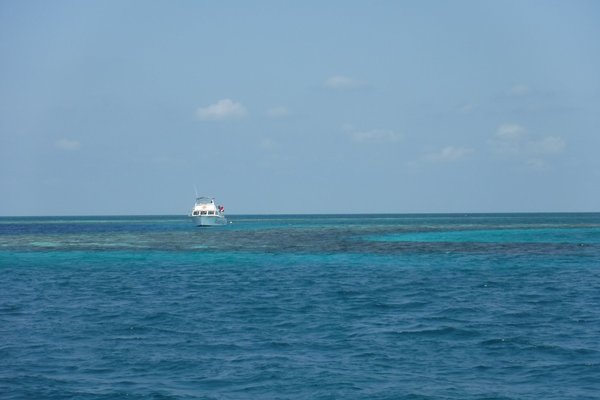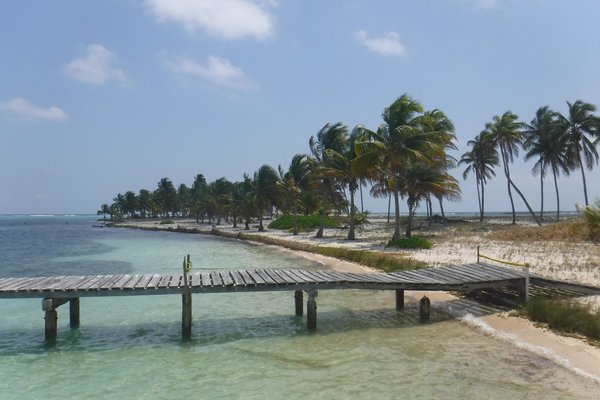Belize
Belize Barrier Reef
The Belize Barrier-Reef Reserve System is a marine and coastal landscape containing a series of coral reefs.
It extends for about 300 km, making it the second-largest coral reef system in the world after the Great Barrier Reef in Australia. A wide array of reef types contained in a relatively small area can be found here. The submarine seascape is diverse, and there are unique geological features such as the Blue Hole and Rocky Point where the barrier reef touches the shore. It is also rich in fauna, ranging from jaguars to great hammerhead sharks.
Community Perspective: It’s a scuba diver heaven, with the Blue Hole as the holy grail (though only experienced divers are allowed to do the most spectacular 40m dive, it is less spectacular at less depth). Half Moon Caye comes recommended even more as it is rich in marine fauna. If you don’t dive or snorkel, your options are to take a sightseeing flight across the reef and the Blue Hole, to visit Bacalar Chico NP which is a land component (covered on a bike by Jarek), or stay on Tobacco Caye. There are also options from Placencia.
Site Info
Official Information
- Full Name
- Belize Barrier-Reef Reserve System (ID: 764)
- Country
- Belize
- Status
-
Inscribed 1996
Site history
History of Belize Barrier Reef
- 2018: Removed from Danger list
- 2009: In Danger
- Due to mangrove cutting and excessive development
- 1996: Referred
- Bureau - Integrity not ensured - boundaries to be changed including adding "Blue hole"
- 1996: Inscribed
- Inscribed
- Type
- Natural
- Criteria
- vii
- ix
- x
Links
- UNESCO
- whc.unesco.org
- Official
-
- travelbelize.org — Blue Hole
- Related
-
- ambergriscaye.com — Link
All Links
UNESCO.org
- whc.unesco.org — whc.unesco.org/
Official Website
- travelbelize.org — Blue Hole
Related Resources
- ambergriscaye.com — Link
News Article
- March 12, 2021 breakingbelizenews.com — UNESCO WH Centre queries impact of cruise ship port construction in Belize
- Jan. 29, 2019 nzherald.co.nz — Belize Blue Hole: Dirty secret found at bottom of pristine natural wonder
- Jan. 16, 2018 travelpulse.com — Belize Protects Barrier Reef with Offshore Oil Ban
- Oct. 25, 2016 news.mongabay.com — Belize suspends oil exploration near World Heritage Site after public outcry
- Oct. 19, 2016 wwf.panda.org — Belize to begin oil exploration near threatened World Heritage site
- Dec. 2, 2015 whc.unesco.org — Government of Belize bans offshore oil exploration at Belize Barrier Reef
- May 11, 2015 theguardian.com — Belize plan to allow offshore drilling threatens Great Blue Hole
- Jan. 6, 2015 theguardian.com — Great Blue Hole off Belize yields new clues to fall of Mayan civilisation
- June 19, 2009 sanpedrosun.net — Belize Barrier Reef recommended to be placed on List of "World Heritage in Danger"
- March 28, 2009 amandala.com.bz — Unesco officials conduct an investigation into dredging activities that have reportedly taken place at one of Belize's main Reserve sites
Community Information
- Community Category
- Natural landscape: Marine and Coastal
Travel Information
Recent Connections
-
Misleading WHS Names
The reef is a well-distinguishable feat… -
Best seen from the sky
Great Blue Hole -
Holocene
the reef was created as recently as 300…
Connections of Belize Barrier Reef
- Individual People
-
-
Cousteau
Great Blue Hole: This site was made famous by Jacques Cousteau, who declared it one of the top five scuba diving sites in the world. In 1971 he brought his ship, the Calypso, to the hole to chart its depths.See en.wikipedia.org
-
Charles Darwin
Charles Darwin described it as "the most remarkable reef in the West Indies" in 1842
-
- Geography
-
-
Situated in one of the SIDS
Belize 1996 -
Caribbean Sea
-
Marine sites
Total inscribed area 96000h. The only "terrestrial areas" are reefs since island areas along the reef have been excluded.
-
- Trivia
- Ecology
-
-
Lagoons
-
Mangroves
-
Molluscs
"350 mollusc species have also been identified" -
Pelicans
Brown PelicansSee ebird.org
-
Sharks
whalesharks, bullsharks, lemonsharks -
Significant Karst Features
Cenotes -
Siraneans
Crit x "Numerous endangered species are protected within the boundaries of the BBRRS including; the West Indian manatee" -
Seagrass beds
seagrass beds interspersed with lagoonal reefs (crit ix) -
Turtles and tortoises
Green turtle, hawksbill turtle, loggerhead turtle -
Blue Holes
Geat Blue Hole near Ambergris CaySee en.wikipedia.org
-
Bird Migrations
The Americas Flyway -
Coral
corals thriving in a pristine condition (OUV) -
Crocodiles
American crocodile (Crocodylus acutus) (AB ev) -
Jaguar habitat
In Bacalar Chico National Park
-
- Damaged
-
-
Threatened by Oil and Gas Exploration
Potential Threat: "A number of Petroleum Sharing Agreements (PSA) in the marine areas used to overlap or be adjacent to the property. An indefinite moratorium on petroleum operations within the limits of the marine zone of Belize was enacted" (IUCN Outlook 2020)
-
- World Heritage Process
-
-
Only WHS in their country
Belize -
First inscriptions
Belize 1996 -
Former In Danger List sites
2009 - 2018 -
Reduced from broader TWHS
After Bureau session, Hol Chan was replaced by the Blue Hole.
-
- Human Activity
- WHS on Other Lists
-
-
WWF Global 200
Marine, Tropical Coral: (235) Mesoamerican ReefSee web.archive.org
-
- Timeline
-
-
Holocene
the reef was created as recently as 3000 years ago
-
- Visiting conditions
-
-
Best seen from the sky
Great Blue Hole
-
- WHS Names
-
-
Misleading WHS Names
The reef is a well-distinguishable feature that can be seen all along Belize’s coast. But only seven protected sites (covering 12% of the surface) have been selected to reflect the whole. While the addition of 'Reserve System' to the name is an indicator of there being limitations, it could be made more clear that it excludes the popular Cayes ('Protected areas of Belize Barrier Reef')
-
News
- breakingbelizenews.com 03/12/2021
- UNESCO WH Centre queries impact of…
- nzherald.co.nz 01/29/2019
- Belize Blue Hole: Dirty secret fou…
- travelpulse.com 01/16/2018
- Belize Protects Barrier Reef with …
Recent Visitors
Visitors of Belize Barrier Reef
- Adam Hancock
- Adrian Turtschi
- Alberto Rodriguez Gutierrez
- alicemears
- Ali Zingstra
- Allegrazwindow
- ALS
- A. Mehmet Haksever
- Ana
- Atila Ege
- Aunti
- beckyjo27
- Bram de Bruin
- Carlos Sotelo
- Cheryl
- Christoph
- Clyde
- Cobaltrage
- Coppi
- CynthiaW
- Daniela Hohmann
- dave wood
- David Aaronson
- del
- Digits
- Don Irwin
- DouglasR
- Dr. Caligari
- Drk9Stormy
- Edisonb420
- Els Slots
- emvcaest
- Eric Lurio
- Erik G
- Eva Kisgyorgy
- Fmaiolo@yahoo.com
- Francky D'Hoop
- Frédéric M
- Gary Arndt
- George Gdanski
- GerhardM
- Gernot
- Gjert
- Harald T.
- H Beswick
- Iain Jackson
- Ilya Burlak
- Jarek Pokrzywnicki
- Jason Boulette
- Javier
- Jawnbeary
- Jens
- J_neveryes
- João Aender
- John Smaranda
- Just_hatched
- KarenBMoore
- Kasper
- KateY
- Kelly Rogers
- kelseyyurek
- kiank37
- Kurt Lauer
- LaVale
- leroykstlj
- Linz
- Lithobates
- Loic Pedras
- Lucas Del Puppo
- Lucio
- Luis Filipe Gaspar
- Lukasz Palczewski
- Mahuhe
- Malgorzata Kopczynska
- Martin
- Max
- MaxHeAnouBen
- Michael Ayers
- MichaelH
- michaelsballard
- Michael Turtle
- MMM
- Monica66
- montgomw
- MoPython
- Morodhi
- Nihal Ege
- Patrik
- Persian Globetrotter
- Philipp Leu
- Pieter Dijkshoorn
- Pincze
- Pink Bunny
- pontobaggins
- Pradip Tripathy
- Qin Xie
- Reiseblog
- RobRos
- Roger Ourset
- Roman Bruehwiler
- Rudegirl
- Sandra!
- Shannon O'Donnell
- Simonf
- Solivagant
- Stanislaw Warwas
- Sutul
- SymonMajewski
- Szucs Tamas
- Tammy Gouldstone
- Tim Allen
- Timothy C Easton
- Toxicologist
- ValiaVeweth
- Waxwing
- Weecheng
- Wo_ko
- Yongcheng Liu
- Zizmondka
- Zoë Sheng
Community Reviews
Show full reviews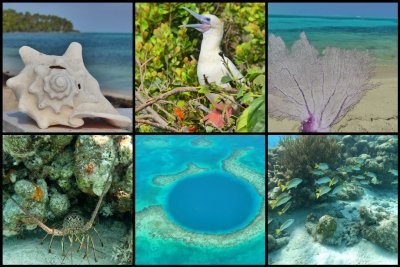
I visited this WHS in Spring 2024 staying close to Half Moon Caye Natural Monument and the Blue Hole Natural Monument. Already getting close to Half Moon Caye, we got lucky and from the boat we saw a couple of dugongs feeding in the middle of the mangroves. If you stop by the mangroves, make sure to wear some mosquito repellent, and beware of crocodiles!
Staying close to Half Moon Caye, meant we were able to come and go at different times of the day with rather short boat trips to enjoy the island and reefs mostly alone. On the island proper, there's a beach which is practically reserved for nesting turtles and a broken down lighthouse where a lot of water birds like to stay. On the opposite side of the island is another lovely beach for swimming, lots of coconut palm trees, a small ranger station with some information boards, and a short hike through the lush vegetation and mangroves, full of hermit crabs, iguanas, lizards and a wooden watchout tower to view the scores of frigatebirds and red-footed boobies and their young in this bird sanctuary. There is a UNESCO WHS plaque for both Half Moon Caye and the Blue Hole Natural Monuments near the Half Moon Caye quay.
We saw lots of different coral, rays, lobsters, conches, moray eels, fish and reef sharks around Half Moon Caye, although snorkelling at the Blue Hole Natural Monument was much better overall with schools of fish, almost …
Keep reading 0 comments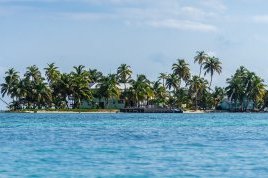
I visited the South Water Caye component in December of 2023. In line with most of the reviews below, I am not a diver, not an underwater photographer, and at best an indifferent snorkeler. Plus, traveling with family members who do not necessarily care for extra efforts to visit a WHS limited me to a single option - some sort of an intraday excursion with plenty of relaxation built in.
Thankfully, in Hopkins where we stayed, resorts offer "island-hopping" expeditions that bring you to several cayes within the reef WH boundaries, including Tobacco Caye and South Water Caye. You do a bit of exploration and then spend an hour or so taking in the sun, the sea, and the tranquility at each. There was a defined snorkeling segment on the reef off South Water Caye. Overall, the expedition lasted about 7 hours, giving my family plenty of what they wanted and me just enough to consider the site as visited to the extent of my interest.
The picture is of Carrie Bow Field Station, one of the scientific outposts on the reef.
Keep reading 0 comments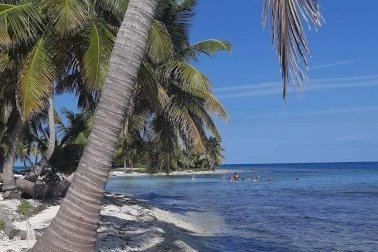
I wanted to point out here one possibility that has not yet turned up in the reviews so far.
I took an afternoon snorkeling excursion from Placensia to the Laughing Bird Caye. The excursion took about 3.5 hours, including a 35 minute choppy boat ride, a short stay on the tiny island and a round of snorkeling and came at a cost of 85 USD.
When our small tour group of three arrived at the tiny island, it was very busy with a big boat moored nearby. It was a strange contrast with the quiet beach in Placensia where we arrived from.
I saw a few corals and fishes during the snorkeling but visibility was not great and the quality of the corals didn't seem amazing either to my unexperienced eyes.
I would not pretend to have really appreciated the site as a whole by this short visit but after considering and pondering for a long time on all the possibilities and options, this came out as the least worst option to me.
In Placensia, also a tour to Glovers Reef was advertised at USD 125 but that tour company did not seem very motivated when I asked for more information so I gave this one a miss.
Keep reading 0 comments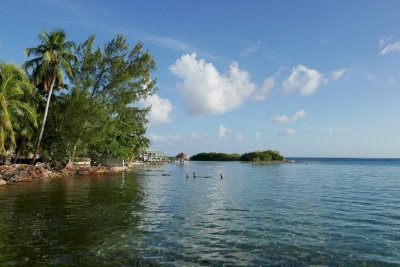
As previous reviewers have written: As a non-diver, it is difficult to visit and appreciate this WHS. If you are a snorkeller and want to visit the core zone, you can either stay in San Pedro or Caye Caulker and book a long and expensive tour that is more geared towards divers. Or you book a stay in an expensive resort on one of the more remote islands.
What to do? After some research I decided to stay on Tobacco Caye. Tobacco Caye is a small island (and small really means small, the island is the size of two soccer fields) that lies within the South Water Caye Marine Reserve and thus the WHS. The island is permanently inhabited and has several basic accommodations. Most importantly, Tobacco Caye is right on the barrier reef and you can snorkel from shore.
I was there for three nights. Other tourists stayed for weeks. The island itself is not a resort or a paradise: Garbage is an issue, and generators disturb the idyll. Nevertheless, I enjoyed my stay. The snorkelling is very good as the reef seems healthy. There are night snorkelling tours offered (recommended) and if enough tourists get together, you can also rent a boat for a tour to the neighbouring islands.
Boats for Tobacco Caye leave in the morning from Dangriga (the ride takes about 30 minutes). It is best to organize your place on a boat through your accommodation. I can't recommend Dangriga itself and would …
Keep reading 0 comments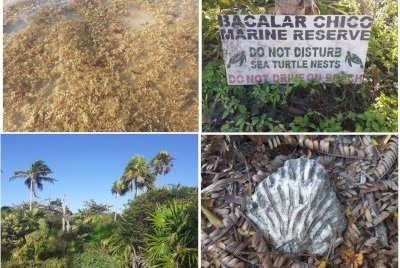
Bacalar Chico national park and marine reserve
Site visited recently, February 2023. With limited time (as always) I decided to visit only small part of the site. Also due to flights schedules I was unable to fly to Blue Hole (no flight on the specific day) I decided to limit my visit only to Bacalar Chico national park and marine reserve as the only relatively accessible (and inexpensive) land component of Belize Barrier Reef.
Access to Bacalar Chico looked as fairly possible form San Pedro town / Ambergris Caye. In fact I arrived by ferry from Belize City to San Pedro (route via Caye Caulker) and immediately started to find out the possibilities of reaching the site. On the map it looked as quite remote but accessible via local road north of San Pedro town. But my host at the hotel who was a former biologist once working for Bacalar Chico strongly advised not to go there alone and certainly not by ordinary bike (because of bad roads, occasional sharp objects or due to problems with security – smuggling narcotics towards Mexican border). He tried to find an organised tour (by boat) to go there but unfortunately there was nothing at my specific date. So his advise afterwards was to go there by golf cart (the most popular transportation mode in San Pedro). But as an experienced biker I decided to rent a bike anyway and realize where I would manage to get on my own.
Next …
Keep reading 0 comments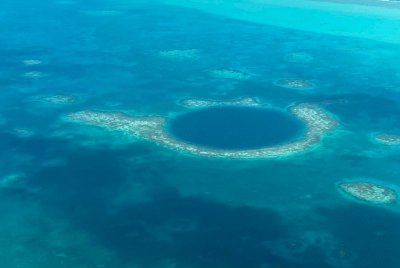
When you’re not a diver and only a reluctant snorkeler, it is hard to turn this WHS visit into a “good” one. Bacalar Chico NP is the only “land” component and my first choice would have been that one. But when I enquired in San Pedro (Ambergris Caye) I heard that there are no scheduled tours that go there, only private boat charters. That obviously would cost too much, so I settled for plan B: a fly-over over the reef. The Great Blue Hole after all is Best seen from the sky.
Both Belizean air companies offer scenic flights over the reef, at a scheduled time a few days a week. I booked with Tropic Air via the chat on their website for the next day. For the steep 262 USD I could have flown much further away, but well, it’s the best I could think of to cover this WHS. Maya Air does it cheaper at the moment (215 USD), but they were slow to react. My flight was flawless, we were on the way for 75 minutes (including a stop at Caye Caulker to pick up a 7th passenger). They fly with a Cessna Caravan, window seats only. It’s a bit like ‘doing’ the Nazca Lines, though without the helpful inflight commentary. There was less twisting and turning here in Belize, so no chance of motion sickness.
The main goal of the flight is the Great Blue Hole, which is a giant marine sinkhole. It …
Keep reading 0 comments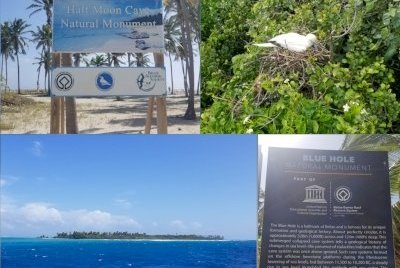
How could I NOT like this place as both a scuba diver and nature lover!
I went to 3 places although I'm confused about the third. Does Bacalar Chico marine reserve include Amergris Caye or not!? I only went on a night dive from San Pedro (full moon makes for the best night dives!!) I know the park has a ranger station with a museum but it doesn't seem worth it, not many trips go out there and I think chances to see a jaguar are as likely in any other park in Belize and espresso northern Guatemala, and by chance I mean like 0.001%.
I took the same trip as Frédéric from Caye Caulker. It takes 2½h to reach the famous blue hole and most people have seen the beautiful birdview picture online, but as you actually anchor on the line you wouldn't really know you are there. I wanted to do skydiving but it's not offered anymore, but anyway the Blue Hole is a marvel.
If you don't dive you'll get very little out of this place and novice divers only went to 24m (78 feet) and there is absolutely nothing to see. Limestone all around and hardly any fishes. I did spot midnight parrotfish as the only exceptional fish although I think it's mainly rare because they aren't in waters I usually dive before. There were supposed to be sharks but nothing on that day. However, go below 40m (that's 130 feet for imperials) …
Keep reading 0 comments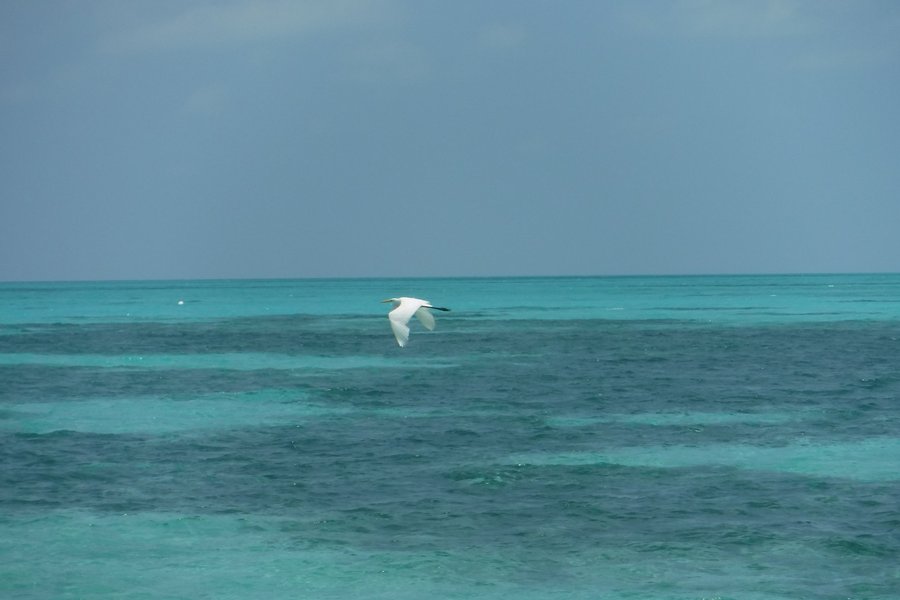
I believe you need to dive (or at least snorkel) the barrier reef to really appreciate the OUV of this site. That was my first dive in the southern seas (what a way to start, I know), so it does not allow me to compare with any other reef system. I chose to visit on a 3-dive trip to Blue Hole and Half Moon Caye from Caye Caulker. I went with Belize Diving Services. They are highly professional and put a lot of emphasis on security.
The boat ride from Caye Caulker is quite long (2-3 hours) and sea can be rough. The first stop was the Blue Hole. I wasn't experienced and certified enough to do the 40 meters dive to see stalactites (other divers even saw sharks), so I did a 20 meters dive along the hole wall, alone with my dive master. It was still a nice dive. We didn't saw a lot of marine life (fishes here and there, moray eel, spiny lobster), but the colour of the water and the impressive underwater wall steal the show. The dark blue water of the Hole is highly contrasting with the light turquoise of the shallow waters around.
The second stop was Half Moon Caye. This dive was the most amazing one of the day. It goes to a shallower depth but this site is much richer in marine life, including big stuff. We saw Caribbean reef sharks, spotted eagle-rays, a loggerhead sea turtle, barracudas, angelfishes, parrotfishes, triggerfishes …
Keep reading 0 comments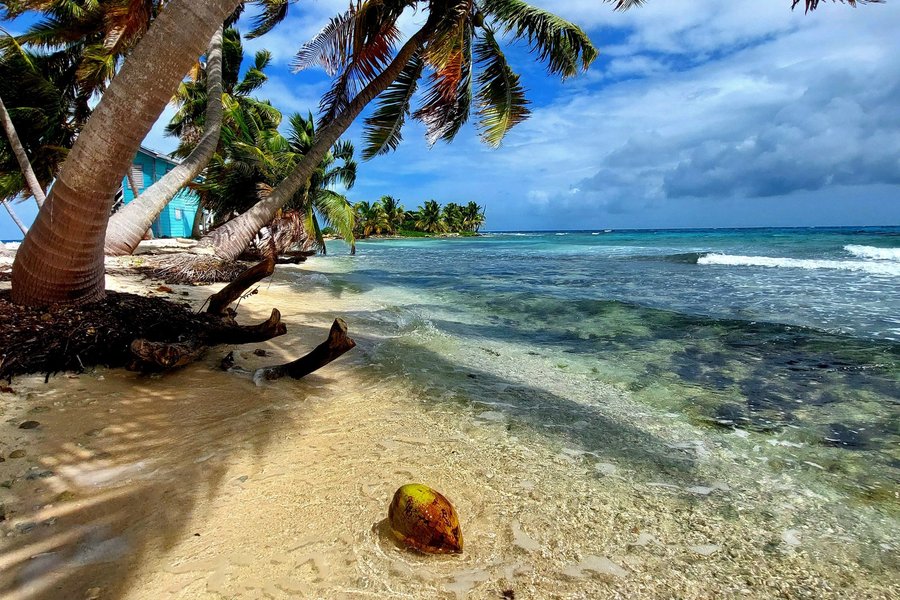
I have visited Belize and its barrier Reef a few times for scuba trips, and its definitely worth a visit. It is less touristy then nearby Mexico, yet has some amazing diving. During the right season you can see whale sharks in the south, and I saw a few white tip sharks in the Blue Hole as well. You have to be careful what dive center you go with, as many in Belize have a bad reputation for being too lax with the rules or dive safety.
Another fun thing to do with your dive operator is the now popular lion fish hunts. They give you little Hawaiian style spear guns, and you get to shoot this invasive species all day. Pretty fun and helps the environment.
Keep reading 0 comments
I went to Belize in the summer of 2005.
Belize's reef is fantastic. I am a PADI diver, and I went with my family. The water is so clear-clearer than the water in Cozumel. Much of the wildlife we saw was diverse and exotic, a big hit with us.
The Blue Hole experience was worth the whole trip. You cannot dive in Belize without going there. Our group (Amigos Del Mar-amigosdive.com) took us on a 2-story boat on a day trip to go to the spot. Getting there was a bit rough-you have to go on the open sea for a few hours, but it would have been much worse had we gone in a smaller boat with less people.
We stopped for lunch at a spectacular snorkeling island (no diving, we had to wait for the hole). So, some of the people we went with just snorkeled and didn't dive.
When we got to the spot, it looked terrific. Pictures don't do it justice.
So, we dove off the side and dove to a depth of 120 feet. It was cold (wetsuits were recommended) and dark. After about 60 feet, the water got very hazy. Looking down, all I saw was abyss. Its a strange feeling.
About halfway through the dive, our boat started throwing chum over the side to summon the sharks at the bottom of the hole, so we saw the sharks rise quite near to us (30 feet). After we got back onto the boat, we …
Keep reading 0 comments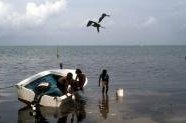
The Belize barrier reef is one of a small group of natural sites where we have visited the “natural phenomenon” but have not actually entered the detailed boundaries delineated by the nomination (limited in this case to 7 relatively small reserves from an overall reef length of almost 300kms). This was largely because we visited it in 1985 ten years before its inscription. Now it may be that the sea is much bluer, the fish much finer and the coral much more spectacular within the boundaries!! But we are not great snorkelers and don’t dive at all so some of the attractions such as the “Blue Hole” would not have been directly accessible to us.
So what was it like? It is one of those useless travel-related “trivia” that the Belize reef is the “second biggest barrier reef in the world” (After the “Great Barrier Reef”)! However in geological terms it is quite special:- “Belize also has one of the most diverse reef ecosystems in the world, with all the main types of reef represented: fringing reefs along the mainland coast; the Barrier Reef itself which grows along the edge of the continental shelf, separated from the mainland by the lagoon; and three offshore atolls …. The presence of atolls is unusual. Most atolls are found in the Pacific, where they form on the top of submerged volcanoes. Very few occur in the Caribbean, and they differ in structure, the three in Belize for example lying on non-volcanic submarine ridges” …
Keep reading 0 comments

